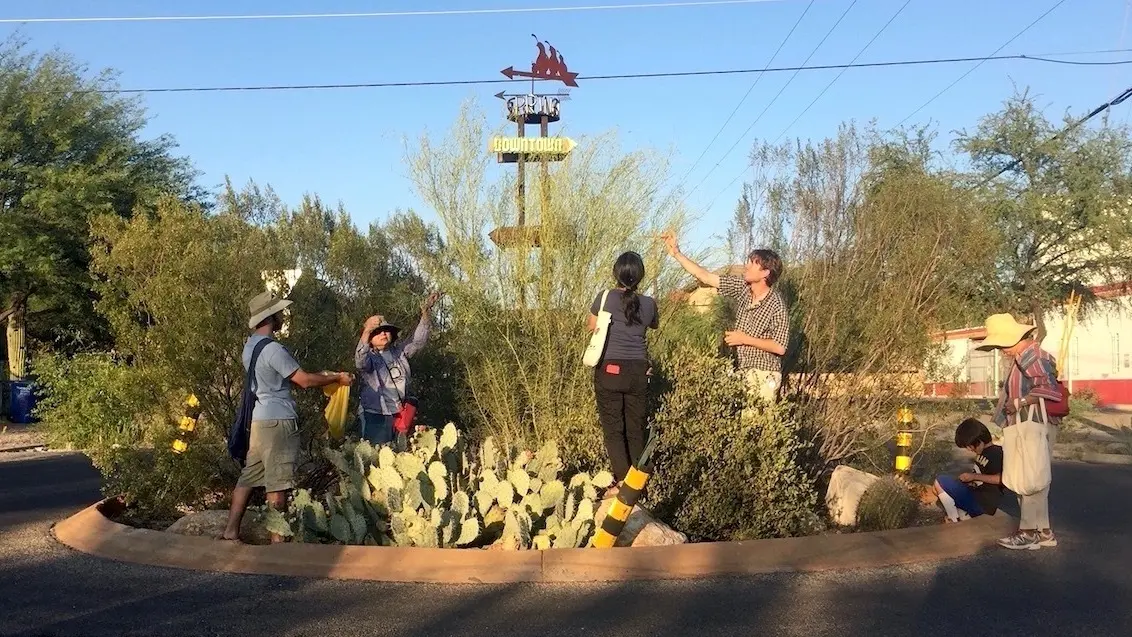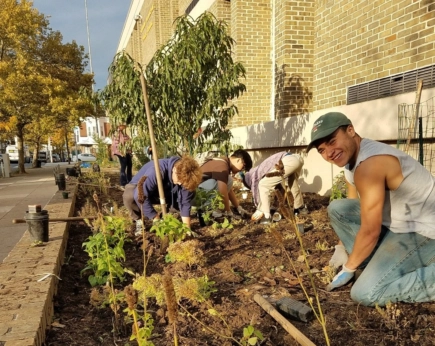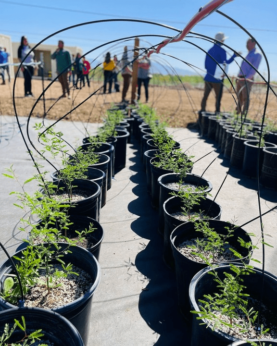Hot? Hungry? Step Inside These Food Forests
In cities like Tucson, Arizona, neighbors are planting trees to provide shade — and food.
Hot? Hungry? Step Inside These Food Forests
In cities like Tucson, Arizona, neighbors are planting trees to provide shade — and food.

by Brad Lancaster, DunbarSpringNeighborhoodForesters.org
Below the red-tile roofs of the Catalina Foothills, an affluent area on the north end of Tucson, Arizona, lies a blanket of desert green: spiky cacti, sword-shaped yucca leaves, and the spindly limbs of palo verde and mesquite trees. Head south into the city, and the vegetation thins. Trees are especially scarce on the south side of town, where shops and schools and housing complexes sprawl across a land encrusted in concrete.
On hot summer days, you don’t just see but feel the difference. Tucson’s shadeless neighborhoods, which are predominantly low-income and Latino, soak up the heat. They swelter at summer temperatures that eclipse the city average by 8 degrees Fahrenheit and the Catalina Foothills by 12 degrees. That disparity can be deadly in a city that experienced 40 straight days above 100 degrees last year — heat that’s sure to get worse with climate change.
The good news is there’s a simple way to cool things down: Plant trees. “You’re easily 10 degrees cooler stepping under the shade of a tree,” said Brad Lancaster, an urban forester in Tucson. “It’s dramatically cooler.”
A movement is underway to populate the city’s street corners and vacant lots with groves of trees. Tucson’s city government, which has pledged to plant 1 million trees by 2030, recently got $5 million from the Biden administration to spur the effort — a portion of the $1 billion that the U.S. Forest Service committed last fall to urban and small-scale forestry projects across the United States, aiming to make communities more resilient to climate change and extreme heat.
But in Tucson and many other cities, tree-planting initiatives can tackle a lot more than scorching temperatures. What if Tucson’s million new trees — and the rest of the country’s — didn’t just keep sidewalks cool? What if they helped feed people, too?

That’s what Brandon Merchant hopes will happen on the shadeless south side of Tucson, a city where about one-fifth of the population lives more than a mile from a grocery store. He’s working on a project to plant velvet mesquite trees that thrive in the dry Sonoran Desert and have been used for centuries as a food source. The mesquite trees’ seed pods can be ground into a sweet, protein-rich flour used to make bread, cookies, and pancakes. Merchant, who works at the Community Food Bank of Southern Arizona, sees cultivating mesquite around the city and surrounding areas as an opportunity to ease both heat and hunger. The outcome could be a network of “food forests,” community spaces where volunteers tend fruit trees and other edible plants for neighbors to forage.
“Thinking about the root causes of hunger and the root causes of health issues, there are all these things that tie together: lack of green spaces, lack of biodiversity,” Merchant said. (The food bank received half a million dollars from the Biden administration through the Inflation Reduction Act.)
Merchant’s initiative fits into a national trend of combining forestry — and Forest Service funding — with efforts to feed people. Volunteers, school teachers, and urban farmers in cities across the country are planting fruit and nut trees, berry bushes, and other edible plants in public spaces to create shade, provide access to green space, and supply neighbors with free and healthy food. These food forests, forest gardens, and edible parks have sprouted up at churches, schools, empty lots, and street corners in numerous cities, including Boston, Philadelphia, Atlanta, Seattle, and Miami.
“It’s definitely growing in popularity,” said Cara Rockwell, who researches agroforestry and sustainable food systems at Florida International University. “Food security is one of the huge benefits.”
There are also numerous environmental benefits: Trees improve air quality, suck carbon from the atmosphere, and create habitat for wildlife, said Mikaela Schmitt-Harsh, an urban forestry expert at James Madison University in Virginia. “I think food forests are gaining popularity alongside other urban green space efforts, community gardens, green rooftops,” she added. “All of those efforts, I think, are moving us in a positive direction.”
Researchers say food forests are unlikely to produce enough food to feed everyone in need of it. But Schmitt-Harsh said they could help supplement diets, especially in neighborhoods that are far from grocery stores. “A lot has to go into the planning of where the food forest is, when the fruits are harvestable, and whether the harvestable fruits are equitably distributed.”
She pointed to the Philadelphia Orchard Project as an emblem of success. That nonprofit has partnered with schools, churches, public recreation centers, and urban farms to oversee some 68 community orchards across the city. Their network of orchards and food forests generated more than 11,000 pounds of fresh produce last year, according to Phil Forsyth, co-executive director of the nonprofit.
Some of the sites in Philadelphia have only three or four trees. Others have over 100, said Kim Jordan, the organization’s other executive director. “We’re doing a variety of fruit and nut trees, berry bushes and vines, pollinator plants, ground cover, perennial vegetables — a whole range of things,” Jordan said.
The community food bank in Tucson started its project in 2021, when it bought six shade huts to shelter saplings. Each hut can house dozens of baby trees, which are grown in bags and irrigated until they become sturdy enough to be planted in the ground. Over the past three years, Merchant has partnered with a high school, a community farm, and the Tohono O’odham tribal nation to nurse, plant, and maintain the trees. So far they’ve only put a few dozen saplings in the ground, and Merchant aims to ramp up efforts with a few hundred more plantings this year. His initial goal, which he described as “lofty and ambitious,” is to plant 20,000 trees by 2030.
The food bank is also organizing workshops on growing, pruning, and harvesting, as well as courses on cooking with mesquite flour. And they’ve hosted community events, where people bring seed pods to pound into flour — a process that requires a big hammer mill that isn’t easy to use on your own, Merchant said. Those events feature a mesquite-pancake cook-off, using the fresh flour.

Merchant is drawing on a model of tree-planting that Lancaster, the urban forester, has been pioneering for 30 years in a downtown neighborhood called Dunbar Spring. That area was once as barren as much of southern Tucson, but a group of volunteers led by Lancaster — who started planting velvet mesquite and other native trees in 1996 — has built up an impressive canopy. Over three decades, neighborhood foresters have transformed Dunbar Spring’s bald curbsides into lush forests of mesquite, hackberry, cholla and prickly pear cactus, and more — all plants that have edible parts.
“There are over 400 native food plants in the Sonoran Desert, so we tapped into that,” Lancaster said. “That’s what we focused our planting on.”
The Dunbar Spring food forest is now what Lancaster calls a “living pantry.” He told Grist that up to a quarter of the food he eats — and half of what he feeds his Nigerian dwarf goats — is harvested from plants in the neighborhood’s forest. “Those percentages could be much more if I were putting more time into the harvests.” The more than 1,700 trees and shrubs planted by Lancaster’s group have also stored a ton of water — a precious commodity in the Sonoran Desert — by slurping up an estimated 1 million gallons of rainwater that otherwise would have flowed off the pavement into storm drains.
Another well-established food forest skirts the Old West Church in Boston, where volunteers have spent a decade transforming a city lawn into a grove of apple, pear, and cherry trees hovering over vegetable, pollinator, and herb gardens. Their produce — ranging from tomatoes and eggplants to winter melons — gets donated to Women’s Lunch Place, a local shelter for women without permanent housing, according to Karen Spiller, a professor of sustainable food systems at the University of New Hampshire and a member of Old West Church who helps with the project.
“It’s open for harvest at any time,” Spiller said. “It’s not, ‘Leave a dollar, and pick an apple.’ You can pick your apple, and eat your apple.”
Merchant wants to apply the same ethic in Tucson: mesquite pods for all to pick — and free pancakes after a day staying cool in the shade.
This story was originally published by Grist. Sign up for Grist’s weekly newsletter here. Grist is a nonprofit, independent media organization dedicated to telling stories of climate solutions and a just future. Learn more at Grist.org
Follow us
This work is licensed under a Creative Commons Attribution-NoDerivatives 4.0 International License.
Want to republish a Modern Farmer story?
We are happy for Modern Farmer stories to be shared, and encourage you to republish our articles for your audience. When doing so, we ask that you follow these guidelines:
Please credit us and our writers
For the author byline, please use “Author Name, Modern Farmer.” At the top of our stories, if on the web, please include this text and link: “This story was originally published by Modern Farmer.”
Please make sure to include a link back to either our home page or the article URL.
At the bottom of the story, please include the following text:
“Modern Farmer is a nonprofit initiative dedicated to raising awareness and catalyzing action at the intersection of food, agriculture, and society. Read more at <link>Modern Farmer</link>.”
Use our widget
We’d like to be able to track our stories, so we ask that if you republish our content, you do so using our widget (located on the left hand side of the article). The HTML code has a built-in tracker that tells us the data and domain where the story was published, as well as view counts.
Check the image requirements
It’s your responsibility to confirm you're licensed to republish images in our articles. Some images, such as those from commercial providers, don't allow their images to be republished without permission or payment. Copyright terms are generally listed in the image caption and attribution. You are welcome to omit our images or substitute with your own. Charts and interactive graphics follow the same rules.
Don’t change too much. Or, ask us first.
Articles must be republished in their entirety. It’s okay to change references to time (“today” to “yesterday”) or location (“Iowa City, IA” to “here”). But please keep everything else the same.
If you feel strongly that a more material edit needs to be made, get in touch with us at [email protected]. We’re happy to discuss it with the original author, but we must have prior approval for changes before publication.
Special cases
Extracts. You may run the first few lines or paragraphs of the article and then say: “Read the full article at Modern Farmer” with a link back to the original article.
Quotes. You may quote authors provided you include a link back to the article URL.
Translations. These require writer approval. To inquire about translation of a Modern Farmer article, contact us at [email protected]
Signed consent / copyright release forms. These are not required, provided you are following these guidelines.
Print. Articles can be republished in print under these same rules, with the exception that you do not need to include the links.
Tag us
When sharing the story on social media, please tag us using the following: - Twitter (@ModFarm) - Facebook (@ModernFarmerMedia) - Instagram (@modfarm)
Use our content respectfully
Modern Farmer is a nonprofit and as such we share our content for free and in good faith in order to reach new audiences. Respectfully,
No selling ads against our stories. It’s okay to put our stories on pages with ads.
Don’t republish our material wholesale, or automatically; you need to select stories to be republished individually.
You have no rights to sell, license, syndicate, or otherwise represent yourself as the authorized owner of our material to any third parties. This means that you cannot actively publish or submit our work for syndication to third party platforms or apps like Apple News or Google News. We understand that publishers cannot fully control when certain third parties automatically summarize or crawl content from publishers’ own sites.
Keep in touch
We want to hear from you if you love Modern Farmer content, have a collaboration idea, or anything else to share. As a nonprofit outlet, we work in service of our community and are always open to comments, feedback, and ideas. Contact us at [email protected].by Max Graham, Grist, Modern Farmer
February 1, 2024
Modern Farmer Weekly
Solutions Hub
Innovations, ideas and inspiration. Actionable solutions for a resilient food system.
ExploreExplore other topics
Share With Us
We want to hear from Modern Farmer readers who have thoughtful commentary, actionable solutions, or helpful ideas to share.
SubmitNecessary cookies are absolutely essential for the website to function properly. This category only includes cookies that ensures basic functionalities and security features of the website. These cookies do not store any personal information.
Any cookies that may not be particularly necessary for the website to function and are used specifically to collect user personal data via analytics, ads, other embedded contents are termed as non-necessary cookies.
Wonder what mesquite pancakes taste like. Would love to try some with locally sourced agave nectar!
I’m so glad this movement is starting to grow. It’s truly needed! Thank you for sharing this.